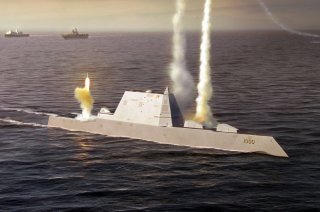Naval History’s Hidden Lesson: The Dangers of Rushed Innovation
In short, the U.S. Navy must affirm Wayne Meyer’s experimental ethos anew. Build, test, learn, and revise before mass-producing a new ship, plane, or system.
Pitrof also documents the industrial bottlenecks and dislocations that resulted from the new mode of propulsion. Small combatants that fell short of their advertised range had to refuel more often. That meant the navy needed many more fleet oilers than anticipated. In turn the demand for auxiliary support ships inflamed the already fierce competition among shipbuilders, not just for raw materials such as steel but for finished components for high-steam plants. Turbines were already in short supply as the shipbuilding sector struggled to fill orders to field the world’s largest armada. So were “main reduction gears,” massive apparatuses that couple steam turbines to the shaft that drives a ship’s propellers. Demand for oilers only exacerbated matters.
High steam made things worse in critical respects, for middling gain in steaming range.
And then unforeseen costs and complexity came to light. For example, it takes special materials such as chromium-molybdenum, or “chromoly,” steel alloy to handle the thermal stresses characteristic of high-temperature boilers. Such materials cost the navy far more than those that went into lower-pressure, lower-temperature plants, and they were scarce in the war’s early going. Furthermore, constructing high-steam plants required specialized machine tools that were hard to come by. The dearth of tools imposed yet another supply bottleneck on the naval buildup—again, allowing Japan to run amok and casting doubt on the war’s outcome.
The age of Harold Bowen feels eerily similar to our own in many respects. Once again the U.S. Navy and industry are scrambling to meet the challenge from an ambitious Asian antagonist, and once again they have run afoul of stiff headwinds. How can the sea service and the larger maritime-industrial complex avoid troubles similar to those set loose by the turn to high-pressure steam?
Two suggestions, both relating to the human factor in martial affairs. One, enthrone the scientific method atop everything the service does. Skepticism is the soul of scientific inquiry. It’s an attitude that befits those who make decisions about procurement. Those in authority should exercise self-discipline rather than seize on the new and untried. Innovation must serve some necessary operational purpose. And however urgent the need for haste, decisionmakers must insist that new-design hardware, software, or modes of operation pass muster under the most realistic conditions possible. That means simulating sea combat against a peer foe.
In short, the U.S. Navy must affirm Wayne Meyer’s experimental ethos anew. Build, test, learn, and revise before mass-producing a new ship, plane, or system.
And two, beware of hype from advocates. Senior leaders should be doubly skeptical if they encounter a Bowen, a proponent who touts some novel thingamajig yet wants to skimp on vetting it. Such a person is a potential single point of failure in fleet design and construction. Better to groom a corps of specialists in any given field, and to encourage debate among backers and critics of what purports to be the next big thing in naval warfare. Productive discord among experts improves prospects for a product that does what the navy and country need.
No innovation comes without costs and tradeoffs. Testing out a new implement of war reveals them—and helps lawmakers and service leaders make wise choices about what to field. And what to forego.
Depend not on whimsy or hunches.
About the Author: Dr. James Holmes, U.S. Naval War College
James Holmes is J. C. Wylie Chair of Maritime Strategy at the Naval War College and a Distinguished Fellow at the Brute Krulak Center for Innovation & Future Warfare, Marine Corps University. The views voiced here are his alone.
Image Credit: Creative Commons.


